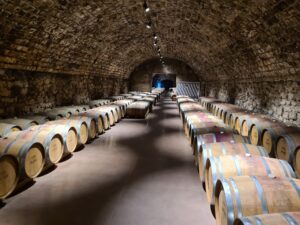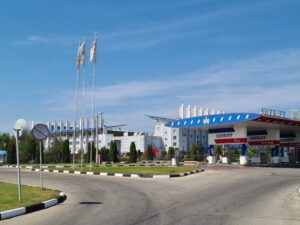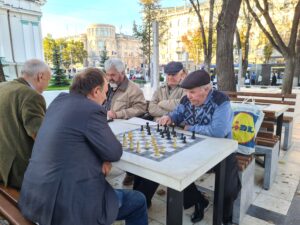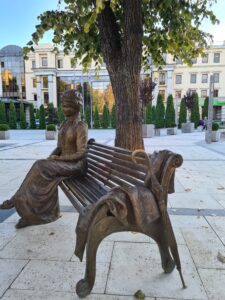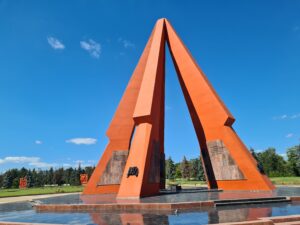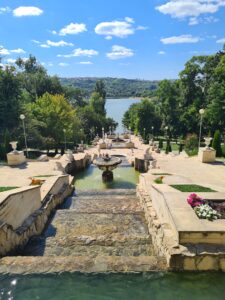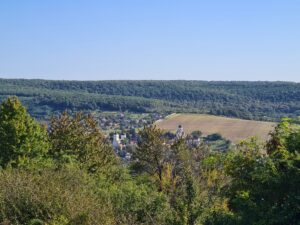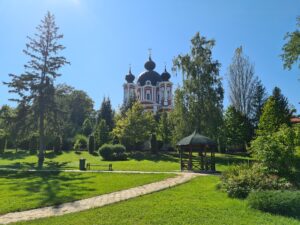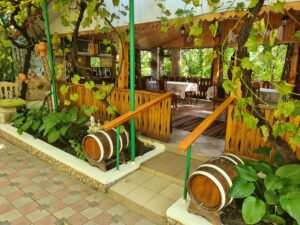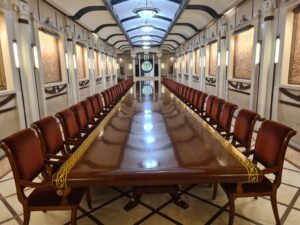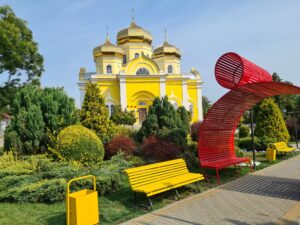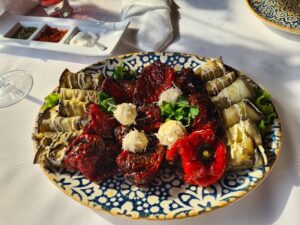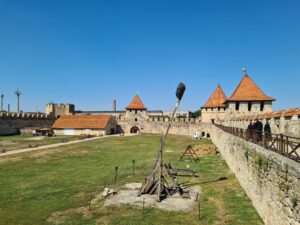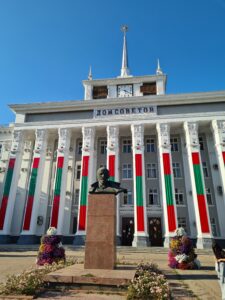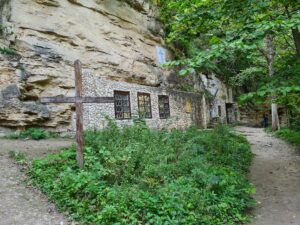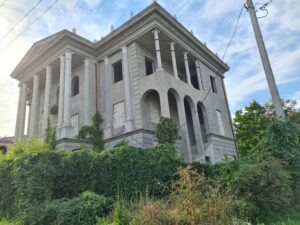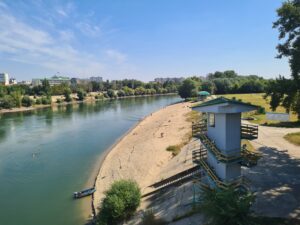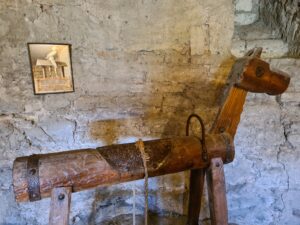Highlights of Moldova
Highlights of this seven-day trip to Moldova:
– the underground tunnels and wine cellars of Cricova, and the tasting of the fine wines
– visiting (still living) monasteries and fortresses in beautiful locations
– meet the friendly, relaxed and hospitable people of Moldova
– stay in two excellent guest houses in villages with local dishes and homemade wines
– a visit to the remarkable ‘non-existent country’ Transnistria
– introduction to the Gagauzians, a unique minority in Moldova
The distances are not particularly big on this trip, which is the advantage of a small country. Moldova is not yet well known in the West and is mainly known for being very poor. Fortunately, reality looks much more positive, thanks to support from the EU and especially the Moldovan diaspora in Europe, which provides additional resources.
Transnistria has existed since 1992 after a short and bloody civil war with Moldova. You will no longer notice that in 2021. The republic is safe, relaxed, has excellent hotels and facilities and is very cheap! The border crossing is not complicated.
A visa is not necessary for a trip in Moldova and neither for Transnistria, but a passport is necessary. Several airlines fly to the capital Chisinau.
Day 1, arrival in Chisinau
Arrival at the airport of Chisinau, the capital, for your tour in Moldova. You will be picked up and transferred to your hotel in the center of the city.The rest of the day is free for you to explore the city. Like many former Soviet cities, Chisinau is spacious with lots of greenery and excellent walking opportunities.
Moldova is known as “the poorest country in Europe”. That may officially be true. However, the impression that the city and country will give you today and during your entire tour will be different. The roads are usually good (partly built with EU money), the houses are mostly in good condition and the people dress neatly. The first conclusion is that Europe is doing well. The second is that the million (or so) Moldovan guest workers and diaspora in mainly EU countries provide for a significant transfer of money that does the country good!
Day 2, city excursion
Today the program includes a city excursion with an English-speaking guide. The excursion is on foot – Chisinau is not very big – but you can also indicate that you prefer to use a car (small extra charge) or public transport.
The guide’s stories bring the city to life, showing the monuments and happenings from before the Soviet era, in it and after.
Moldova is a country between east and west, between the EU & Romania on the one hand and Russia & Ukraine on the other hand, and that contradiction revolves around many of the choices that the country had and has to make, even to this day.
If you start the city excursion on time – an average excursion lasts two to three hours – and afterwards you want to discover even more with the guide, it is possible to visit the nearby underground wine cellars of Milesti Mici. And of course taste the wines. This is the largest underground ‘wine city’ in Europe and the tunnel complex has no less than 200 km of roads underground!
Incidentally, the program for the next day includes a visit to another underground wine city that is just as impressive, namely Cricova. So, the extra opportunity today is for the real wine lovers. There is an additional cost (see prices tab).
Another alternative today is to visit one of Chisinau’s excellent museums with a guide, or else on your own, such as the National Museum of Ethnography and History of Nature.
Day 3, monastries, wine tasting and a homestay
Today you leave Chisinau and get to know the area north of the capital. A varied program awaits you.
First of all, at an hour’s drive from Chisinau, you will visit the monastery of Capriana. Stephan the Great, the great hero in the history of Moldova, is the founder of the stone church built between 1491 and 1496 dedicated to the Assumption of the Virgin Mary.
Your trip in Moldova is not complete without a visit to at least one of the famous underground wine cellars, or rather wine towns. Today a visit to the underground wine cellars of Cricova is on the program. Its underground tunnel complex comprises of no less than 120 kms of roads. After WWII, the largely destroyed Chisinau had to be rebuilt and for this purpose the widely available limestone was used. The result was large empty underground spaces. In 1952 it was thought that they could perhaps be used for viticulture, i.e. storage of wines. That four-year experiment succeeded and that’s how Cricova was born.
The tunnel system and the storage and production of wines underground are impressive. Moldova is serious about this tourist attraction and everything is excellently arranged underground. Be amazed and enjoy the production of wine and the special tasting rooms, and even a small church. Of course, the excursion will be concluded with a wine tasting!
The next leg, and perhaps you will have lunch first, will take you to a second monastery, Curchi. This is the oldest monastery in Moldova and, like Capriana, a working monastery. It is beautifully situated in green surroundings.
Orheiul Vechi
You will end today in the area with the most famous authentic villages of Moldova, namely Orheiul Vechi. The landscape is breathtaking, consisting of a sharply cut canyon, in an otherwise mostly hilly country. The highlight of Orheiul Vechi is a 13th-century monastery located in a cave carved into the limestone.
The two villages in the area are Butuceni and Trebujeni. Both are very authentic and a pleasure to explore on foot. Your guesthouse for the night, and where you will also have a delicious Moldovan meal, is located in Butuceni. WiFi, a private room with private toilet and bathroom are included. And don’t skip the homemade wine!
Day 4, Gagauzia
A completely different excursion and experience awaits you today. After an extensive breakfast, there is first a transfer of about two and a half hours through the not unpleasant Moldavian countryside (read: hilly country with a lot of viticulture, other agriculture and also forest) to the town of Comrat south of Chisinau. Comrat is the capital of the Republic of Gagauzia. Chances are you’ve never heard of this republic, that can boast its own president and police.
Gagauzia has about 160K inhabitants who originally came from Central Asia and eventually ended up in present-day Moldova via Bulgaria and Russia at the end of the 18th century. Remarkable about this Turkish people is that they are Orthodox Christians. After the independence of Moldova in 1990, a civil war such as in Transnistria could hardly be prevented, but the republic did receive a degree of autonomy.
You will meet the Gagauzians in the capital Comrat and visit the National Museum in a village, dedicated to the history and ethnography of the country and its people. This includes a unique collection of old film footage of the colonization of the steppe in the area by the Gagauzians. Finally, you will spend the night in a beautiful, traditional Gagauz guest house with delicious local meals – and wines.
Day 5, welcome in Transnistria!
Today, a visit to another disputed area is on the agenda, namely Transnistria. After breakfast you make a transfer of about two hours, first of all to the town of Bender, with a famous fortress. For that you will cross the border, because the independence of Transnistria goes a lot further than that of Gagauzia. A visa is not required, but you do need your passport.
Transnistria fought a short but bloody civil war for independence with Moldova in 1992 and, with the help of Russia, managed to achieve a significant degree of independence. The situation of 1992 is virtually unchanged in 2021 for the almost half a million inhabitants. Transnistria is de facto independent of Moldova with free gas from Russia (Moldova pays) and a Russian ‘peacekeepers’ garrison of 1,400 men in the center of the capital Tiraspol that guarantees independence.
Bender & Tiraspol
After the (in our case fast) border control you will visit the medieval fortress of Bender, built in a Turkish era. During our visit in 2021 there was work in progress, i.e. ongoing archaeological research.
Distances are small and not much later you will reach the capital Tiraspol. Along the way you will undoubtedly notice the various companies (supermarkets, gas stations) with the ‘Sheriff’ logo. Because that’s the all-owning shadowy (like the entire economy of the area) company that suddenly finds itself in the global spotlight in 2021 as the namesake of the successful soccer team FC Sheriff, playing in the Champions League!
You’ll experience Tiraspol with a guide and will not miss the references and influence of Russia, including a huge statue of Lenin and memories of WWII. A visit to the market is recommended, the locals are very friendly and relaxed.
You spend the night in an excellent four star hotel in the center.
In the evening you can go out on your own, the city is (just like the cities in Moldova) safe and pleasant.
Day 6, Saharna Monastry and a Gipsy neighbourhood
After breakfast, you will return to Moldova for yet a completely new adventure. In just under two hours, including another border crossing, you reach the monastery complex of Saharna. In 1964 all monks were expelled here and the complex was used as a storage room for a school. The church served as a hospital. In 1990 it was put back into use as a monastery, and completely renovated in 1992.
The final part of the day is a visit to Soroca, just like Saharna located on the river Dnistria. Here is an impressive (and restored) fortress dating from the time when Genoa ruled here.
An attraction of a completely different order is a visit to the gypsy quarter of the town. Be amazed by the most fantastic structures, often copies of famous buildings, which all have in common that they are unfinished business and still being built. This has the advantage that no tax has to be paid for it….
Transfer back to Chisinau (2 hours) and your hotel in the city center.
We hope you have enjoyed the hospitality and special attractions that the country has to offer, as well as two special autonomous regions. And have you been able to determine that Moldova is in better condition than the media would have us believe?
Day 7, back home
Transfer to the airport for your flight back home. End of your tour in Moldova.
The cost of this program is €1,095 per person at two persons, €895 p.p. at four persons and €695 p.p. at 6 persons. For other group sizes, please write to us.
Included in the price are:
– two nights in a centrally located 4* hotel in Chisinau in a standard double room incl. breakfast
– one night in a centrally located 4* hotel in Tiraspol in a standard double room incl. breakfast
– two nights in pensions in villages including breakfast and dinner, also the costs for the driver and the guide
– all transfers in a spacious comfortable car, at four and six people in a minibus
– English speaking local guides throughout the program
– entrance fees for all museums and sights according to program
– costs for wine tasting in the program
– unlimited mineral water en route
Not included in the price for this tour in Moldova are the international flights, an early check-in on day 1, lunches & dinners (except twice), tips and the services not mentioned. Finally, we withhold a contribution of €15 for the GGTO Guarantee Fund.
PLACES |
Moldova & Transnistria |
DATES |
all year |
PRICES |
€695-895-1.095 per person at 6-4-2 persons |
LENGHT |
7 days |
Contact
-
Telephone
tel. (00)31 23 700 12 22
(00)31 6 47 12 64 09
-
Email
